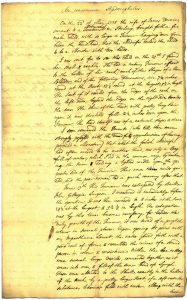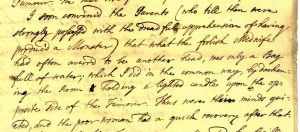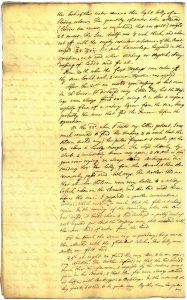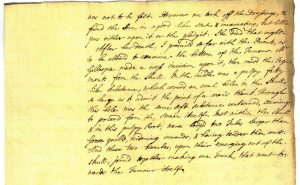The next post in our celebration of Scotland’s ‘Year of Young People’ concerns a medical case in which a tiny baby was operated on as an experiment by a Stirling Doctor and Surgeon, in the late 18th century. The medical men are well-meaning in their attempts to treat the tiny girl but clearly have no experience of her condition or the respources to draw upon anyone else’s knowledge. This document highlights how dangerous surgical intervention was in the days before anaesthetics and antibiotics and a clear understanding of the causes of many medical conditions, and how lucky we are to have the benefits of modern medicine today.
This handwritten report relating to the case of a Stirling child was found amongst the papers of the Murray family of Polmaise and Touchadam. It is unsigned but has clearly been written by a medical man with an interest in this unusual case. It is a sad and distressing read to modern eyes, as the tiny child who was born with the complaint described did not survive for very long after the treatment she was given for it. Neither she nor her family are named. Initially at least the doctor was able to help the family, who, on seeing the child emerge with a large tumour at the back of her head, believed that the mother had given birth to a monster with two heads and were extremely distressed. The doctor was able to reassure the parents that this was nothing supernatural but was actually a tumour, and proved this by placing a candle behind it to show how the light from the flame was visible through the growth.
The poor child had to endure surgery without anaesthetic to remove the tumour, which was performed by ‘Bailie John Gillespie, Surgeon’, and was then bandaged and observed regularly. The writer shows a mixture of natural compassion for his tiny charge coupled with professional curiosity at the unusual nature of her ailment. Although the surgery was initially regarded as successful, she only survived for 9 days. The parents allowed the same surgeon to perform a post-mortem examination and the findings are described without any conclusion being drawn from this.
Although the writer described the baby’s condition as ‘hydrocephalus’, which means fluid on the brain, the diagnosis today might well be different. In an era before antibiotics, anaesthesia and sterile operating conditions, this poor infant stood little chance of surviving the treatment given her for her condition. One cannot help observing that she might have fared better had the medical men not been allowed to experiment on her for their own interest.



